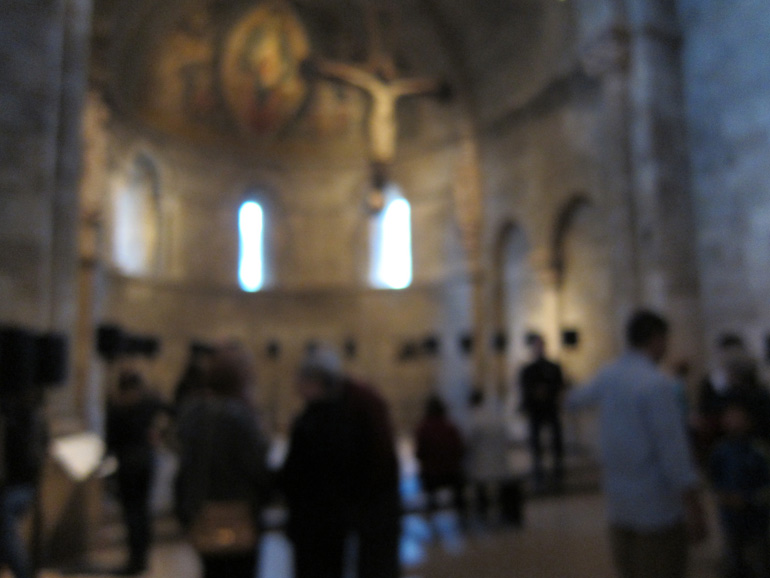Outing:
Forty-Part Motet
14 October 2013
If I had taken a clearer picture of the Fuentadueña Chapel at the Cloisters, I’d have used it, but although I brought home more than a few interesting snapshots from my outing to the Cloisters this morning, this clouded image captures something of the the experience of hearing Thomas Tallis’s Spem in alium (the “forty-part motet”) cast from forty speakers, each one registering a single voice, in a stone hall of middling size. The installation, by Jane Cardiff, dates back to 2001, and has been heard in New York before, at least once that I know of, a few years ago at MoMA. I hope that it will be regularly revived at the Cloisters.
Although written in the second half of the Sixteenth Century — no one is quite sure when, although a noted performance was given at Arundel House in London, probably before and in honor of Queen Elizabeth I — and although it reflects contemporary harmonic taste, Spem in alium is something of a throwback to the vast complications of the late medieval style, which lacked the tonal propulsion of the latest music from Italy. It stands out even among Tallis’s many other works of church music; perhaps it would be better to say that it stands back from them. I don’t want to say more, because all I know about Spem in alium is its oddness; I’ve only just downloaded a score. Hitherto, the motet has come across as a tidal surge, with ebbing echoes, and never have I been able to make out a single word after that opening “spem.” Although some voices are felt to be going up or down, there appears to be no overall direction to the piece, the effect being rather one of massive sustention. The simple point of Cardiff’s project is to make the voices intelligibly palpable, but even with one speaker per voice, the texture repeatedly fuses, as if to transcend music itself, in something even further from noise.
Determined not to be late, I arrived long before my friend. Climbing the steps from the sweep, I could hear nothing and despaired – it’s not on today. It wasn’t until I was getting my admission sticker that I made out distant music, coming in fact from fairly nearby. I had read somewhere that the motet is “piped through the museum.” This is not so. It is largely contained within the chapel itself.
I arrived as the motet was ending (it loops all day long, with intervals of perhaps five minutes between performances), and I stood in the doorway, so as not to disturb. People were standing throughout the chapel, but only a few were moving; most were transfixed. When the singing stopped, and the dazed listeners shuffled out of the room, I made my way to bench, sat down, and read the final scene of The Tempest. I closed the book when the first soprano cut the air. Spem. Hope. Trust, rather: “[Lord,] I have never trusted in another.”
Perhaps because it is hard to be hopeful or trusting these days. it is a relief of sorts to be overcome by Tallis’s grand joyous solemnity. I tried to make hearing it out an act of faith.
***
Excerpts from a letter to the friend who accompanied me to the Cloisters, written after I’d given up trying to capture the experience of Spem in alium at the museum, and just settled into listening to the music a few times — with a score.
When I got home, I listened to the recording of Spem in alium that I bought at the Cloisters [by the Tallis Scholars], and it seemed clearer even than the performance in Jane Cardiff’s installation. I also located a downloadable score. Very dense and hard to follow, but it gave me the feeling that I was on solid ground at last and not floating through some improbable Elizabethan impressionism. I also realized that I don’t know a thing, really about this music, and that made it difficult to write about the experience. I took out the bits about weeping, too. I had, as you may have guessed, sat through a performance before you arrived, and my response was “emotional.” No matter how I came at it, I could not mention this in a way that didn’t strike me as insufferably conceited. Perhaps intuitive readers will “read” my tears into the dreadful photograph that I used.

